Content source: https://www.ifourtechnolab.com/blog/how-to-secure-asp-net-core-web-app
Asp.net Core is the most powerful, versatile, and complete framework, widely used by a developer to develop web, desktop, mobile, and cloud-based web application. Unlike Mobile and Desktop application, web application runs on the publicly available address so that the security of web application is important.better features in Asp.Net Core with best security practices, but still, there are Vulnerabilities and it is our responsibility to secure our web application before and after launching our Asp.net core web application.
Why .Net core is better for security?
Asp.net provide features like authentication, authorization, data protection, HTTPS enforcement, app secrets, XSRF/CSRF prevention, and CORS management. So that developer can easily configure and manage security for their application.
ASP.NET Core provides tools and libraries such as built-in identity providers, party identity providers such as Facebook, Twitter, and LinkedIn to secure your web application.
Common Vulnerabilities

Vulnerabilities
Software Vulnerabilities means weakness or flaws present in code or anything that allows information security to be exposed to a threat.
Asp.net core contains features that help the developer to secure their web application and prevent security breaches. It is recommended to get best security tips to secure the application There are more vulnerabilities that the developer should be aware of. The following list contains the most common Vulnerabilities:
- Cross-Site Scripting (XSS) attacks
- SQL injection attacks
- Cross-Site Request Forgery (XSRF/CSRF) attacks
- Open redirect attacks
Cross-Site Scripting (XSS) attacks
Cross-Site Scripting (XSS) is a security vulnerability in which an attacker place client-side scripts (usually JavaScript) into web pages. When other users access affected pages the attacker's scripts will run automatically and, enabling the attacker to steal credentials from cookies and session tokens. A hacker can change the contents of the web page through DOM or redirect the browser to another page.
XSS vulnerabilities generally occur when an application interacts with the user through the input and outputs page without validating, encoding, or escaping it.
The script can be injected in the following ways:
- Form Inputs
- URL Query Strings
- HTTP Headers
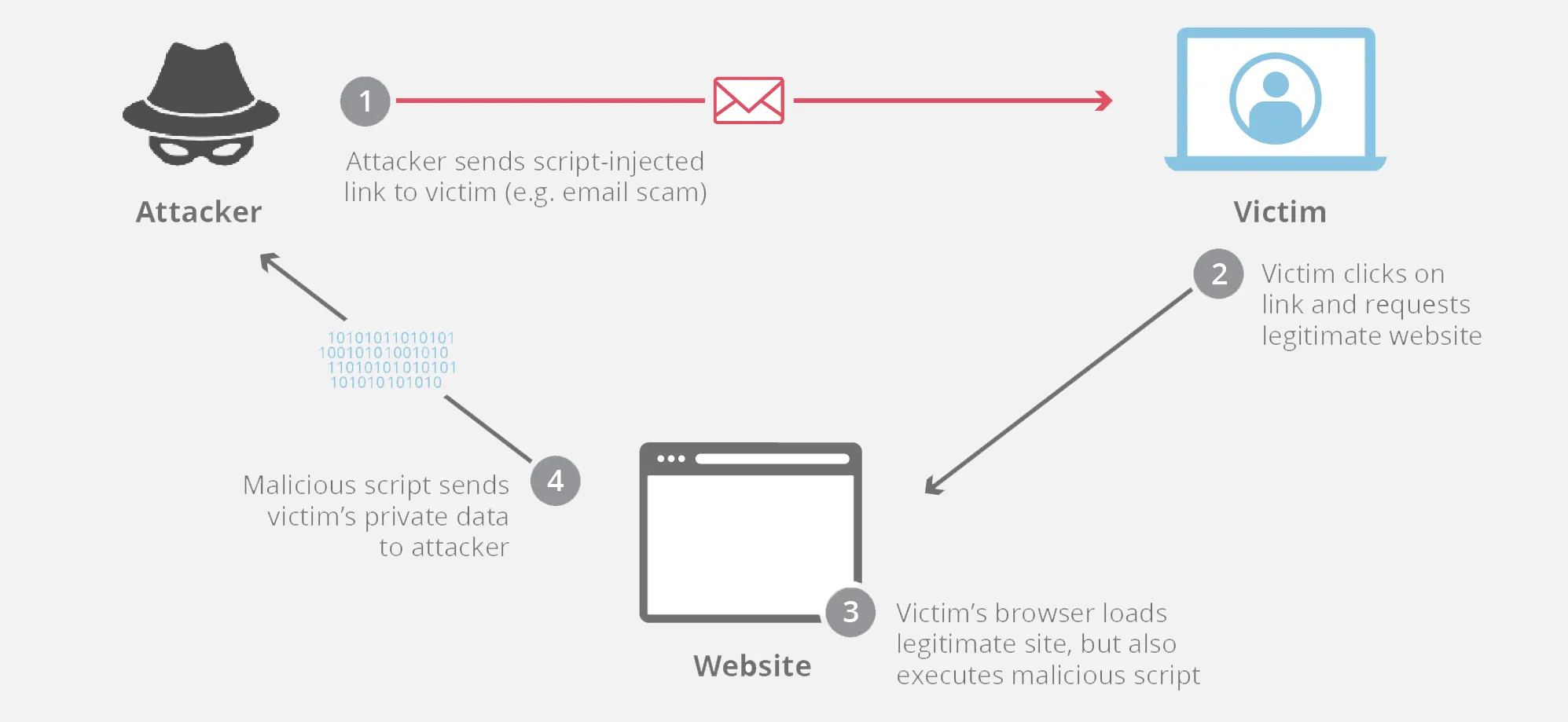
How to prevent cross-site scripting
Cross-site scripting can be prevented in the following way:
- Regular Expression Attributes
- Regular Expression Object Model
- HTML Encoding
- URL Encoding
Read More: Using Linq In MVC .NET Core
Regular Expression
Using regular expression form inputs can be validated and the user's form denies special character, symbol and only allow required character before proceeding to the next page.
Note:Using Regular Expression, you can perform Client and server-side validation
Regular Expression Object Model
Using the regular expression object model, the developer can validate user inputs by calling static methods of the Regex class.
HTML Encoding
The Razor engine used in MVC automatically encodes all input sourced from variables so that malicious script will never be executed. <,”, >used in attack.
So,Razor engine encode val in following format:
HTML fileURL Encoding
Usually, the developer used plain text in the query string which causes an XSS attack so we should use an encoded query string. You can use the default encoder provided in
ExampleSQL injection attacks
SQL injection attack is the most common attack. In SQL injection attacker place malicious SQL code that then runs in your database and allowing the attackers to access confidential information stored in the database.
In SQL injection the unauthorized user places some condition or special characters in the input field which causes to change in the execution of the whole query.
Example
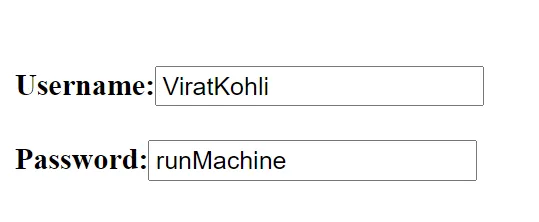
SELECT * FROM db WHERE Username ="ViratKohli" AND Password ="runMachine"
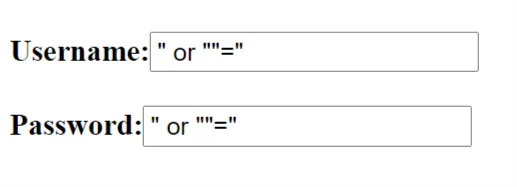
SELECT * FROM db WHERE Username ="" or ""="" AND Password ="" or ""=""
How to Prevent SQL Injection?
SQL Injection can be prevented in the following way:
- Validate inputs
- Use stored procedures
- Use parameterized queries
- Use Entity Framework or any other ORM
- Store encrypted data
Validate Inputs
Validate the user inputs on both the client-side and server-side using Regular expression and data annotation and Don't allow special characters that are used in SQL script.
stored procedures
Use store procedure to prevent SQL injection but also validate parameter pass to store procedure.
Use Parameterized Queries
Example:
Use Entity Framework or any other ORM
ORM stands for the object-relational mapper, which maps SQL objects to class. Use Entity Framework for preventing SQL injection because Entity Framework uses a parameterized query.
Store Encrypted Data
Use Encryption technique for confidential data like email, password, etc.
Cross-Site Request Forgery (XSRF/CSRF) attacks
An attacker takes advantage of an authorized session. An attacker acts as a trusted source between authorized user can web and sends some forged data to a site. The site processes the forged data because it believes that data comes from an authorized user.
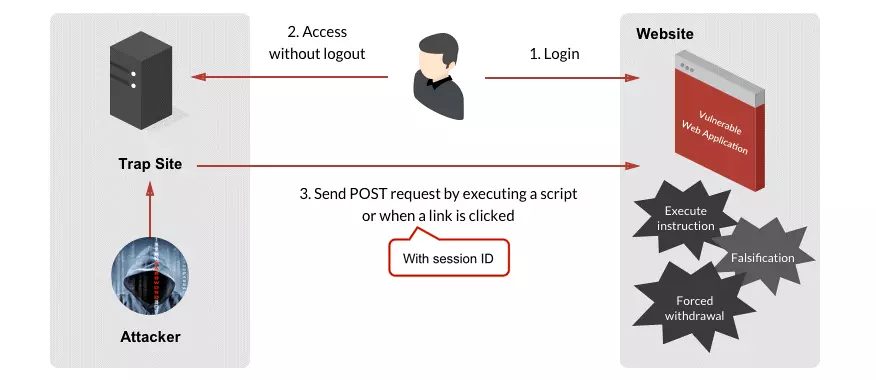
How to prevent cross-Site Request Forgery
Using AntiForgeryToken developers can prevent an attack. we can use the anti-forgery attribute in the Html tag and set it value as true. The default value for anti-forgery is false. Add [ValidateAntiForgeryToken] attribute in the post method to check whether a valid token is generated.
...
@Html.AntiForgeryToken()
Open redirect attacks
Web applications frequently redirect unauthenticated users to a login page when they access resources that require authentication. After successful authentication, The Redirection URL typically includes return URL query string so that the user can be returned to the original Requested URL.
Redirection URL is specified in the query string of the request, an attacker can tamper (interfere with (something) to cause damage or make unauthorized alterations.) with the query string. Query string allows users to redirect to an external, malicious site.
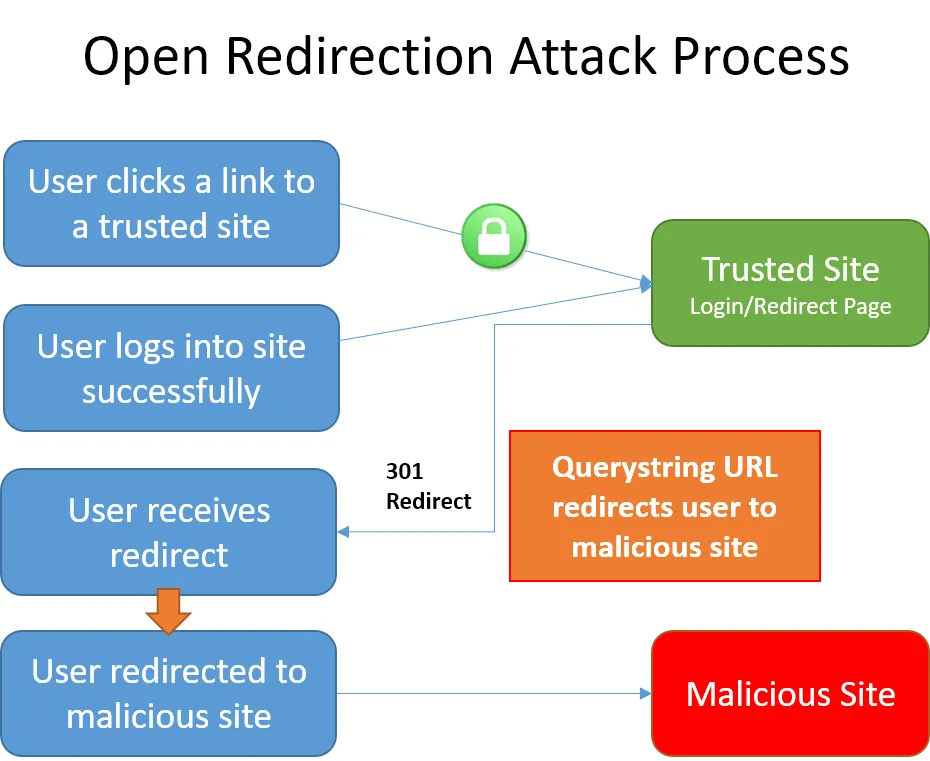
Use LocalRedirect Method
The local Redirect method is the same as the Redirect method but throws an exception when a nonlocal URL is specified.
Searching for Dedicated ASP.NET Core Web Developer? Your Search ends here.
IsLocalUrl
Using the the the IsLocalUrl method user can test URLs before redirecting and protect users from being redirect to malicious sites.
Important Point for securing Asp.net core web application
Use Custom Error Page for Error Handling
Sometimes, Exception may not handle properly and can lead to the exposure of sensitive information such as database configuration info, table names, stored procedures, data structures, and programming coding structure to users.
How to Add Proper Custom Error Handling
Secure Login
Login Page is like an entrance door for any Application. If attacker can get access to Admin Panel then he/she can access whole application. So, Securing Login is important.
How to Secure Login:
Use complex login credentials
Never use common username and password for Admin Panel.
Example: Never user Username like admin and Password like 1234.Use Strong Username and Password.
Always use .net core identity featureAsp.Net Core provides many built-in libraries & tools to secure your applications. Use Authorization for complete sign in and signup process.
Suggestions:
- Use Captcha Like Match Captcha, Letter Captcha in your login because bot can’t fill captcha
- Block IP address if use fails login for more than 1 time
- Include Alphabets (A-Z & a-z), Digits (0-9) & Special Characters (! , @, ., #, $, %, ^, &,* and more) in your password and make it strong.
Use Encryption
Example:
Use Hash function to encrypt your sensitive data. Include following namespace in your program.
Encrypt your data using following function
Clear CookiesManage cookie and remove cookie after logout.
Example: Delete all Cookies after logout. Use Response.Cookies.Delete() method to delete all cookies
Use SSL
Use SSL stands for Secure Socket Layer to make the communication between Client & Server Side Encrypted using a very strong Key. Access application in HTTPS mode. Starup.cs of your Asp.Net Core Application, you can set Secure Policy for Cookies.
Use SSL stands for Secure Socket Layer To makes the communication between Client & Server Side Encrypted using a very strong Key. SSL provide secure layer between user and Server so that the requests passed between the user browser and the server, and the responses from the server to the user browser, will be encrypted to maintain the integrity and security of the data.
Access application in HTTPS mode. HTTP (Hypertext Transfer Protocol Secure) is used to security in your ASP.NET Core application.
Configuring for HTTPS option is available in Visual studio when selecting web application template
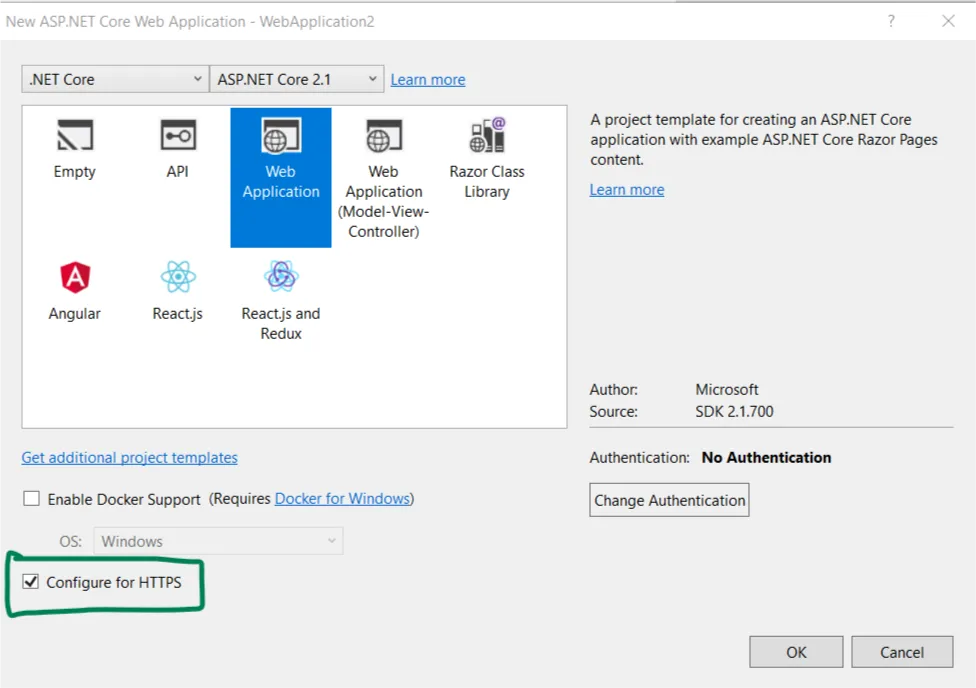
Starup.cs of your Asp.Net Core Application, you can set Secure Policy for Cookies.
Read More: How To Secure Public Apis In Asp.NET Core?
HSTS (HTTP Strict Transport Security)
HSTS is a web security policy that prevent your web application from cookie hijacking and provide communication over an HTTPS connection. HTTP Strict Transport Security always rejects insecure HTTP connections.
The asp.net Core web application by default add HTTP Strict Transport Security
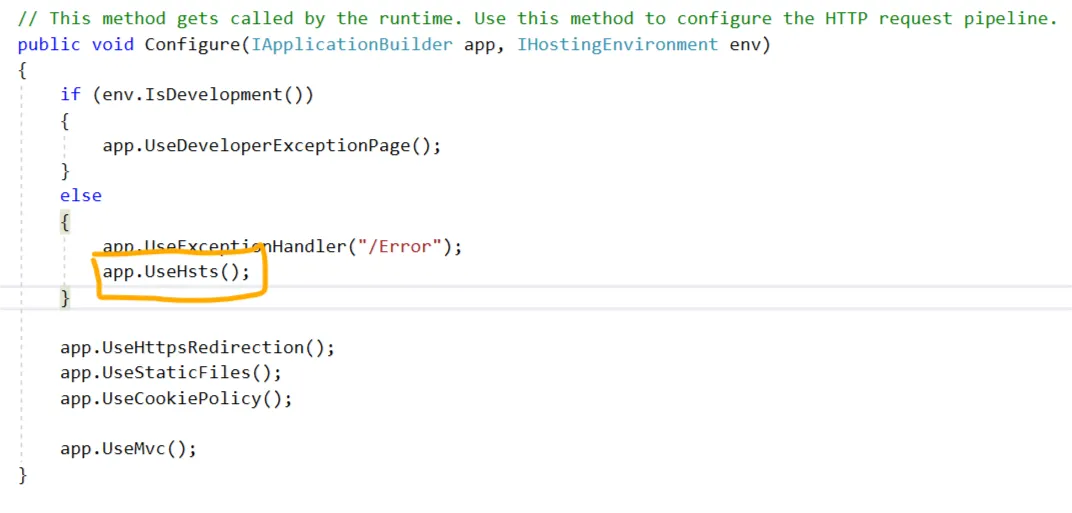
Use Audit Trails
It is a best practice to keep monitoring web application activity logs and used to gather information like login attempts.
Log4Net Elmah are the most commonly used library for activity logging.
Custom Implementationyou can use custom implementation of activity logging.
What to store as Log
- User Email/Username/Id
- Full Name
- Ip Address of Client System
- Current Time
- JavaScript Navigator user Agent Property
- Log Type activity (e.g. Login, Logout, Edit Profile Info, Change Password)
How to get JavaScript Navigator userAgent Property
Simply navigator.userAgent single statement is used to get JavaScript Navigator useAgent Property in Asp.net core web application.
How to get client Ip address?
You can use following statement:
Hide Version
Remove Asp.net version Header
Whenever the client sends an HTTP request to the server in response, the client gets a response header with the following information:
- server
- x-powered-by
- x-aspnet-version
- x-aspnetmvc-version
- x-sourcefiles
Server: Server Name.
X-Aspnet-Version: This shows the ASP.NET framework version used by website.
X- AspnetMvc-Version: This shows the ASP.NET MVC framework version used by website.
X-SourceFiles: Used by local host.
Remove X-Powered-By HeaderApply the following changes in the web configuration file
Remove X- AspnetMvc-Version Header
Apply the following changes in the Global.aspx file
Remove X- Aspnet-Version Header
Apply following changes in web configuration file
keep Framework & Libraries Updated
Always use an updated framework and library. Never use outdated Libraries or framework in your Project because attacker always keeps finding the Vulnerabilities in old Frameworks & Libraries.
Conclusion
Asp.net is one of the most secure frameworks but we have to still protect our application from malicious activity. By common practices, users can easily develop secure .net core applications. Using these practices user can prevent their application from various attacks.



.jpg)
No comments:
Post a Comment